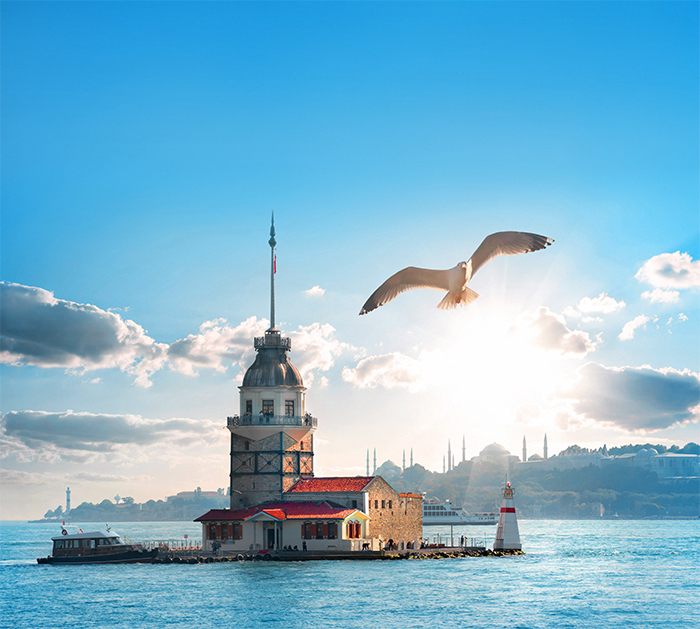Türkiye’s largest city, Istanbul, is located in the north-west of the country, lying across the shores of two seas, divided down the middle by the Bosphorus Strait. The only city in the world to be built over two continents, Istanbul has acted as a bridge between Asia and Europe, and as a sea bridge between the Black Sea and the Mediterranean throughout its history. Founded in the 7th century BC, this crossroads of civilisations has had several names over time and has been the capital of multiple empires and cultures. This rich past is reflected in the many historic monuments and sites of archaeological significance that can still be seen around the city today, particularly on Istanbul’s Historical Peninsula, which is home to a group of sites that were inscribed as a UNESCO World Heritage Site in 1985. Perhaps the best-known historic site in Istanbul is Ayasofya-i Kebîr Cami-i Şerîfi (Hagia Sophia Grand Mosque). This impressive structure was built in the 6th century AD as an Eastern Roman basilica and was later transformed into a mosque under Sultan Mehmed II in 1453, and then a museum in 1935, before being redesignated as a mosque in 2020 by the Republic of Türkiye’s Council of State. When first constructed, the building’s 31m-wide dome was the largest in the Eastern Roman Empire, and the splendid monument still dominates the skyline of old Istanbul today.

Next to Hagia Sophia is the Sultanahmet Mosque, also known as the Blue Mosque. The mosque incorporates elements of Eastern Roman design alongside traditional Islamic architecture, and bears some resemblance to Hagia Sophia, despite the fact that it was constructed over a thousand years later, in the Ottoman era, 1609-1616. The mosque’s six minarets are another prominent feature in the iconic Istanbul skyline, and the inside of the building is just as captivating, with 200 stained glass windows, as well as the 20,000 İznik tiles that give the Blue Mosque its name. In front of the mosque sits Sultanahmet Square, or the Hippodrome of Constantinople, which was once used for public events such as chariot racing. Another significant site that makes up part of the ‘Historic Areas of Istanbul’ UNESCO World Heritage Site is the Topkapı Palace, which sits on the Seraglio Point, overlooking the Golden Horn. The palace was constructed in the 15th century and served as the sultans’ residence and the administrative centre of the Ottoman Empire for several centuries. The palace is now home to a museum that houses a collection of Ottoman artefacts, religious relics, and manuscripts, and visitors can explore parts of the vast palace complex including the Imperial Harem – the exclusive domain of the royal family – and the treasury.

However, not all of Istanbul’s most spectacular historical structures are visible from the street. 52-steps below ground level is the Basilica Cistern, the largest of the hundreds of cisterns that lie beneath the city. Covering an area of 9,800m2, the cistern has the capacity to store 80,000 cubic metres of water for the city, but today the water is kept at a low level so that visitors can see the impressive underground chamber. The cistern was constructed by Emperor Justinian I in the 6th century AD and is named after the earlier Roman Basilica that stood once in this location. The ceiling is supported by 336 9m-tall marble columns, many of which appear to have been recycled from buildings across the Eastern Roman Empire. Of particular note are the bases of two columns in the north-west corner of the cistern, which are shaped like the head of Medusa. One of these heads has been placed upside down, while the other is sideways – theories about the reason for this range from simple space restrictions to suggestions that the position is intended to counteract the power of the gorgon’s stare.

The Historical Peninsula is not the only area of Istanbul that is home to ancient monuments. Located across the Golden Horn, on the opposite shore, is Galata Tower, which was constructed in 1348 by the Genoese who had settled in this area in the 12th century. At almost 63m high, the watchtower was the tallest structure in the city for centuries, and still offers impressive 360-degree views of Istanbul from the top balcony today. It is also home to a museum showcasing objects from throughout the city’s history. On a small island at the southern entrance of the Bosphorus Strait sits the Maiden’s Tower, or Leander’s Tower. Originally built in the Eastern Roman period, the tower has been rebuilt several times throughout its history, and has had a variety of functions – from lighthouse to quarantine station – but is now home to a café and restaurant offering views of the city.

Other significant sites include the Süleymaniye Mosque, Dolmabahçe Palace, Çırağan Palace, Beylerbeyi Palace, the Grand Bazaar (one of the oldest covered markets in the world), the medieval Rumeli Hisarı (Rumeli Fortress) on the European shore of the Bosphorus and Anadolu Hisarı (Anatolian Fortress) on the Asian side, and large sections of the impressive City Walls that are still standing today. Indeed, everywhere you go in Istanbul you will come across historic monuments, churches, mosques, aqueducts, palaces, and mansions – a testament to the city’s rich and storied past.
